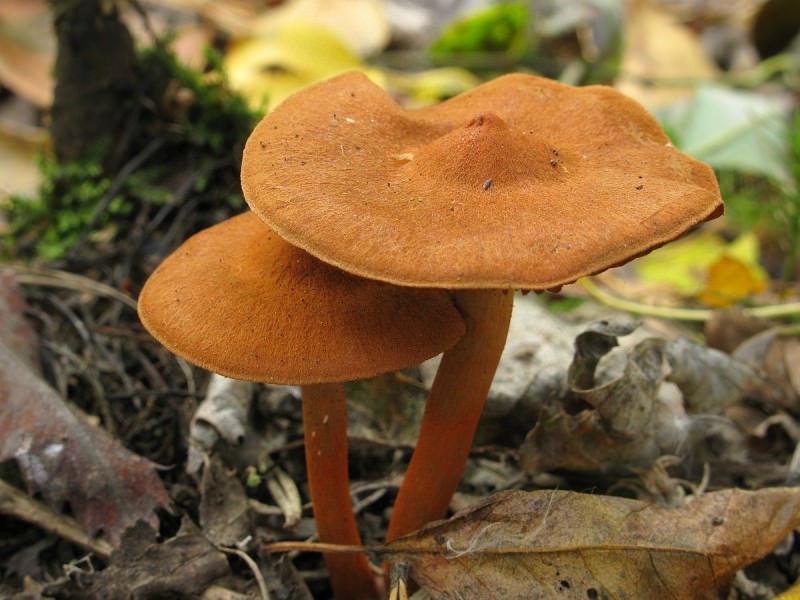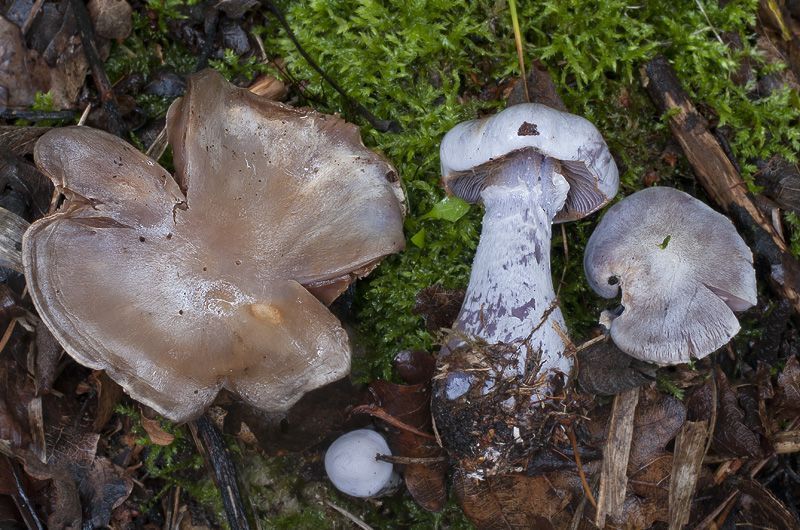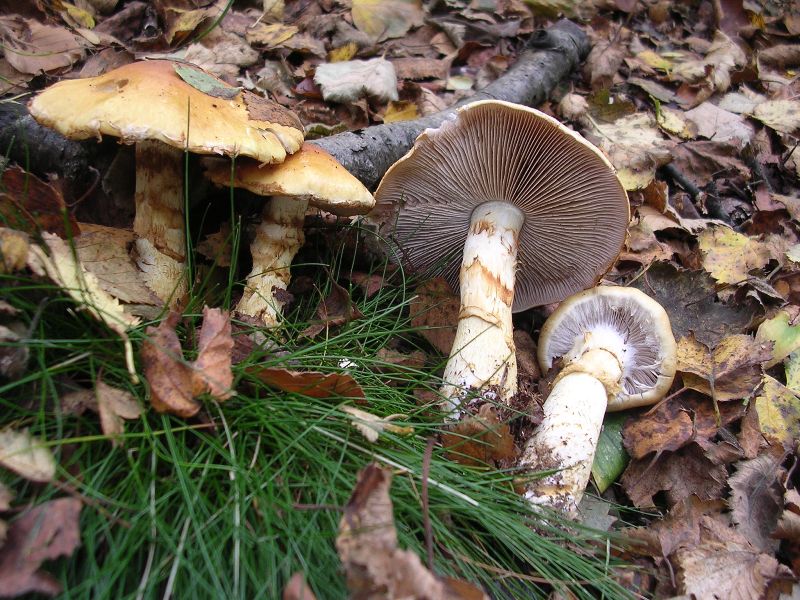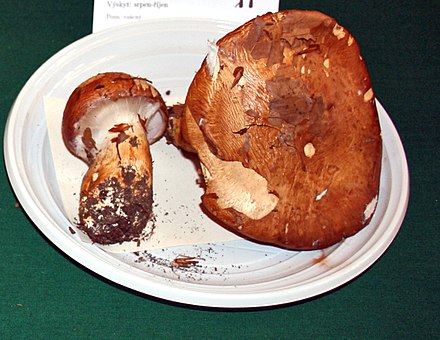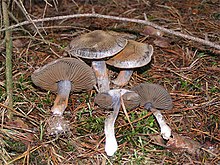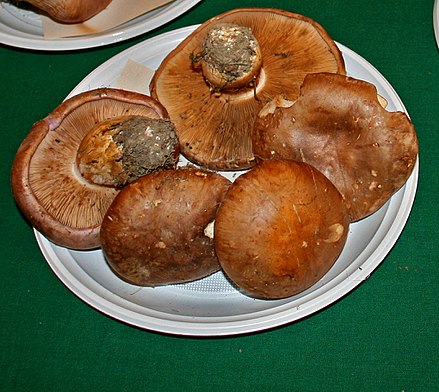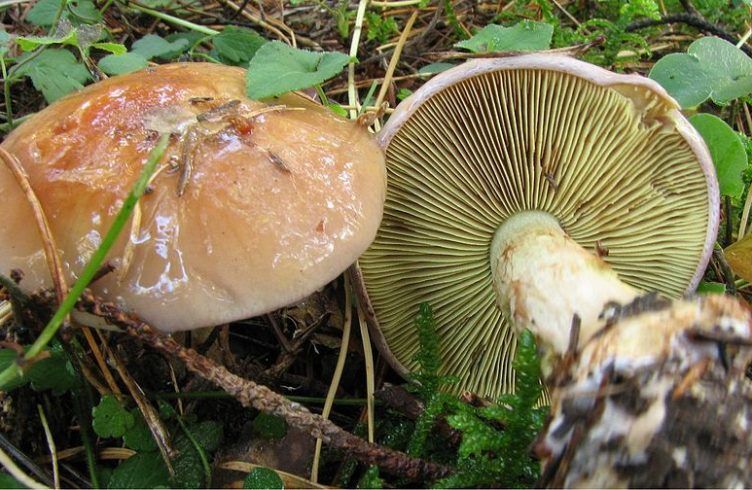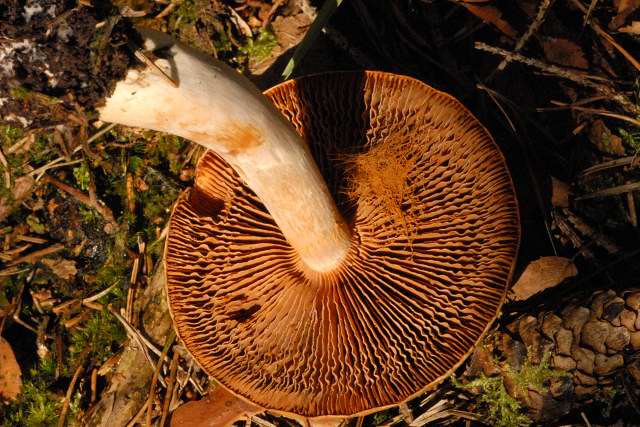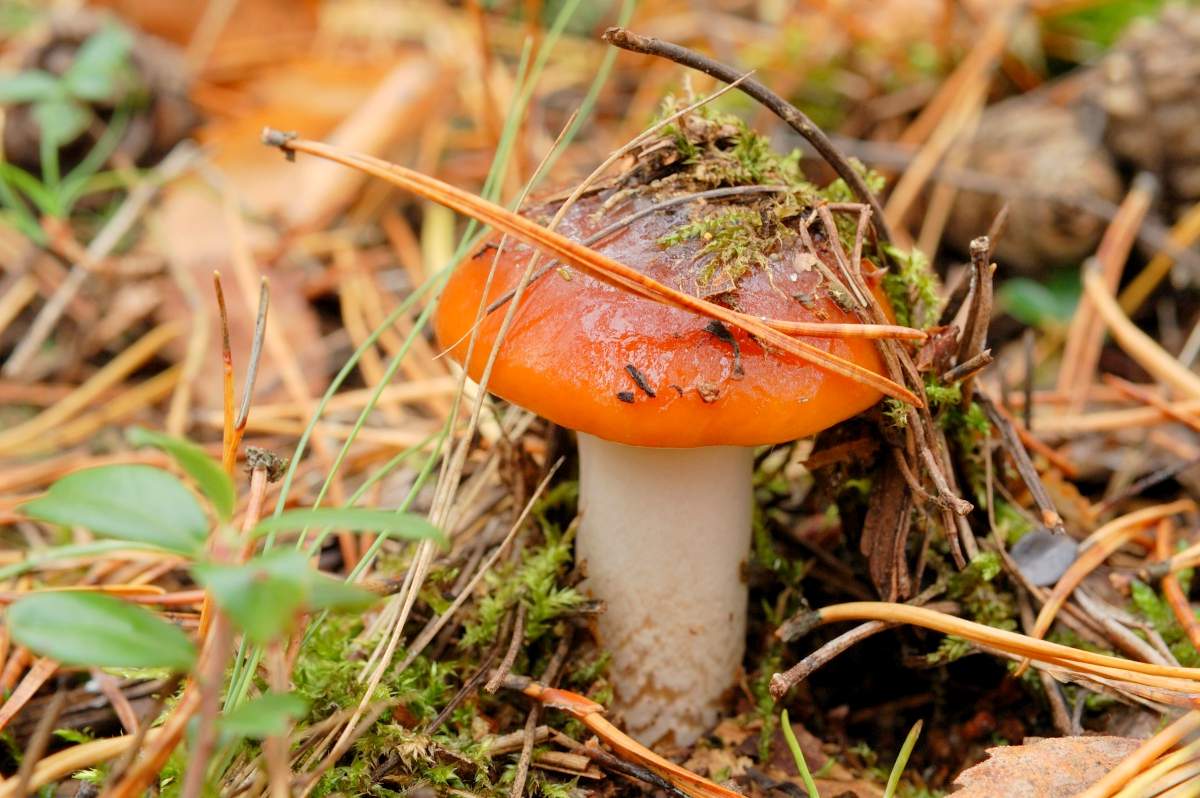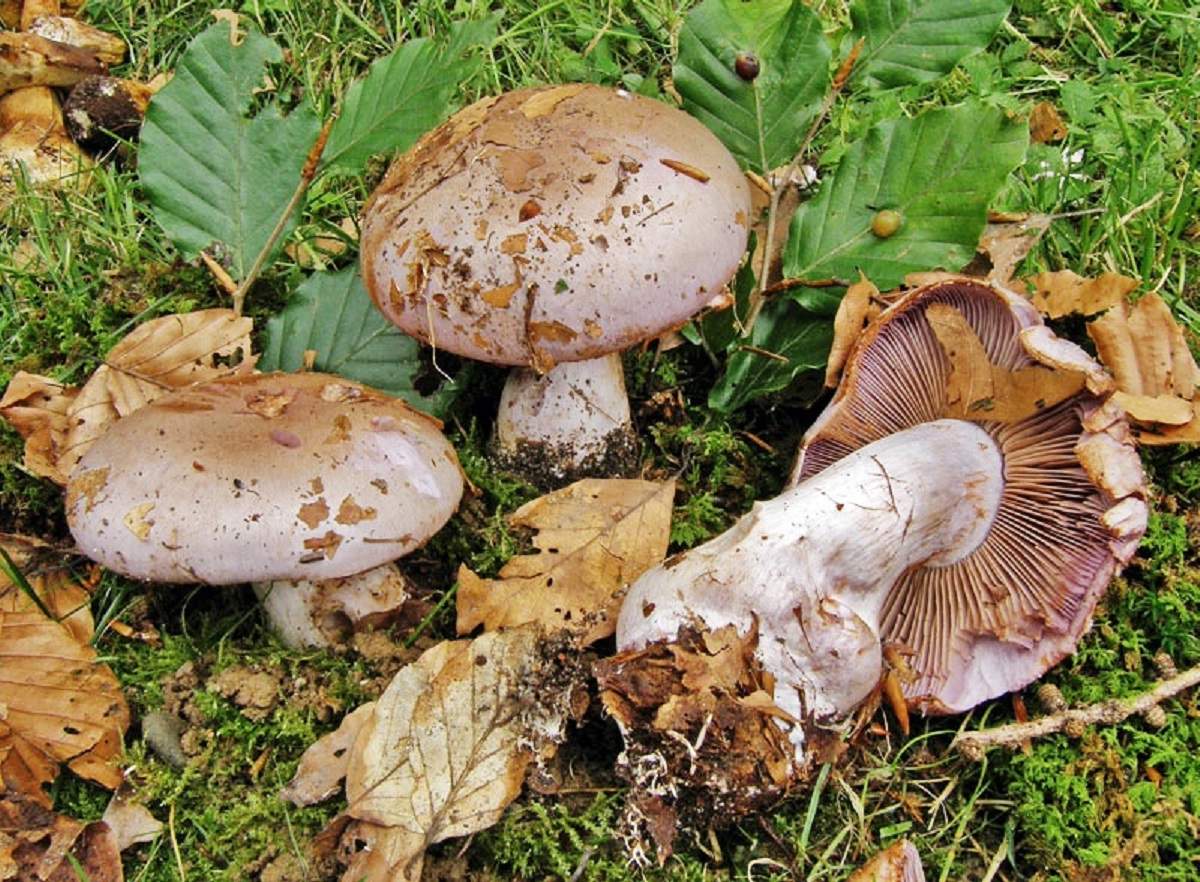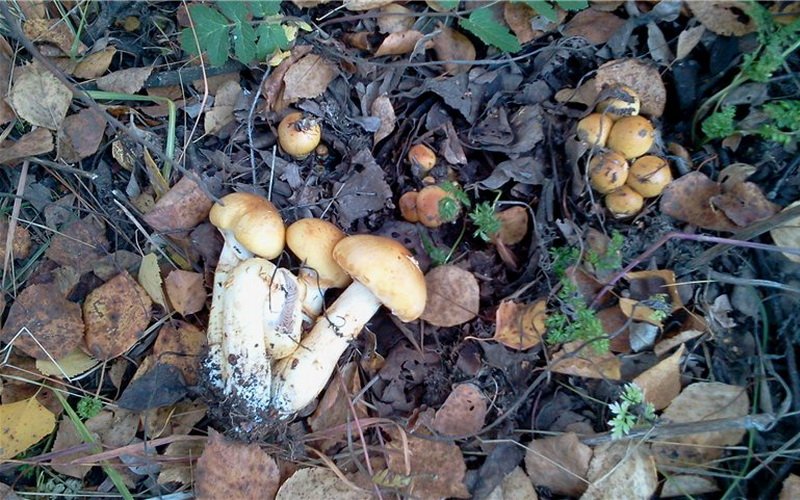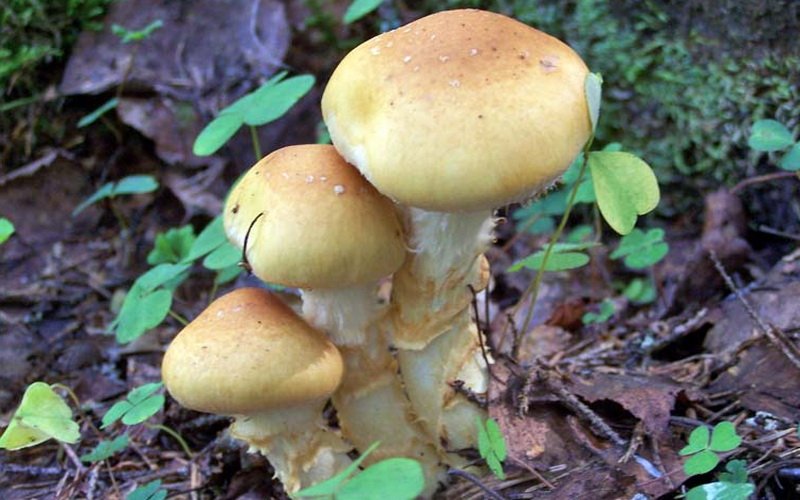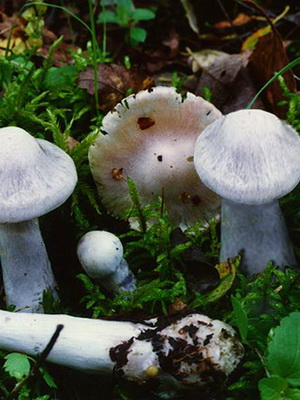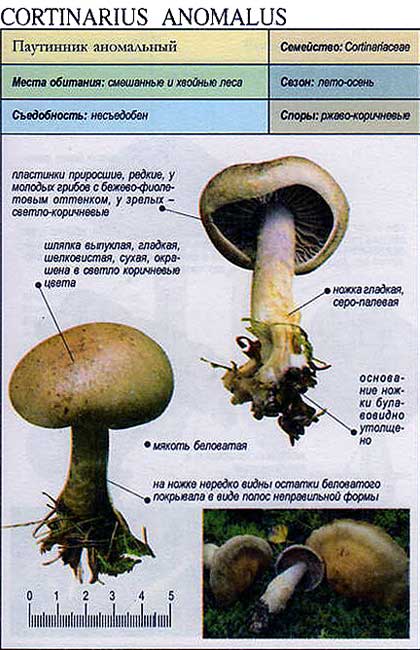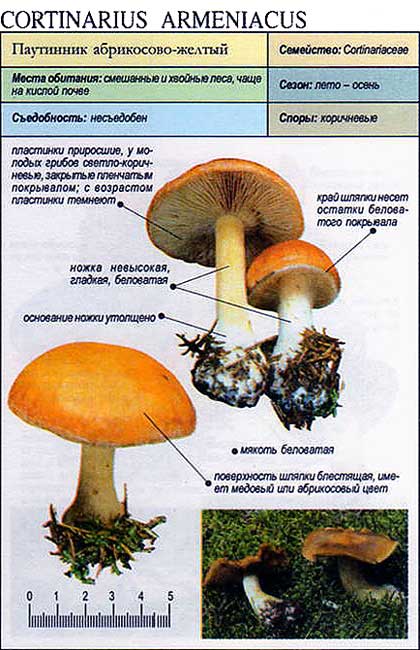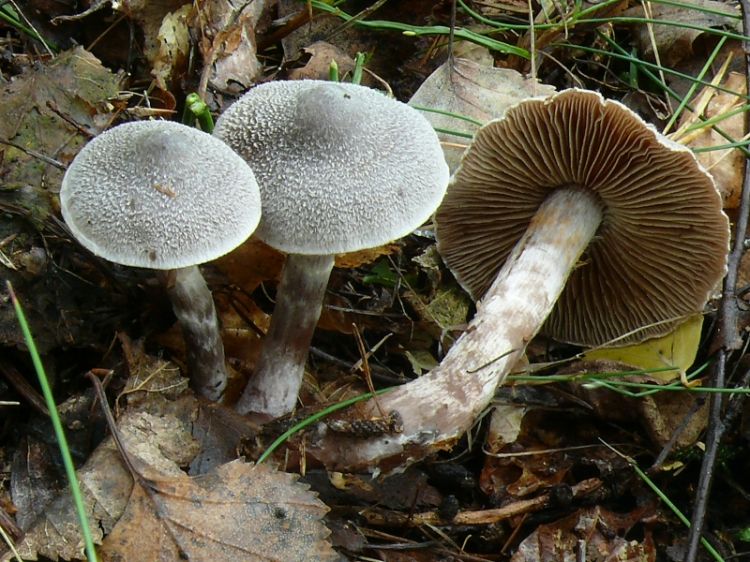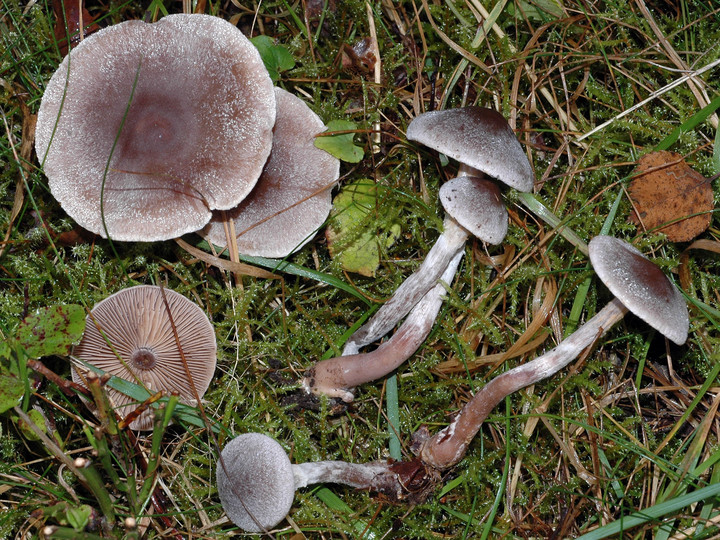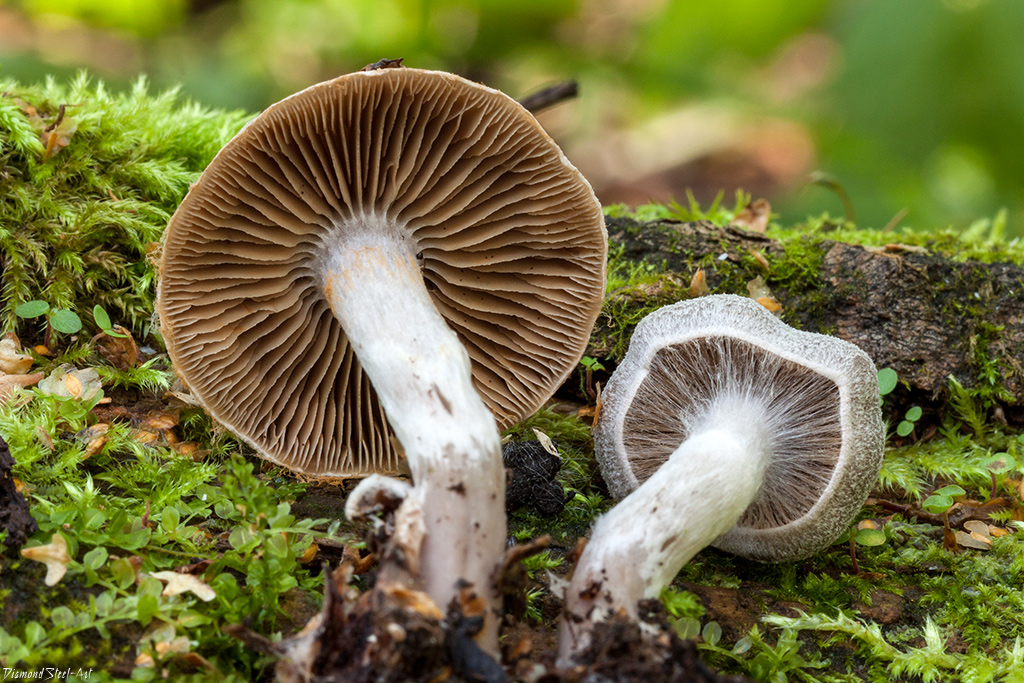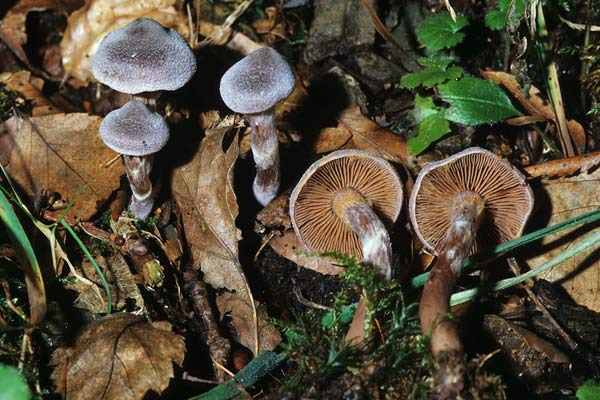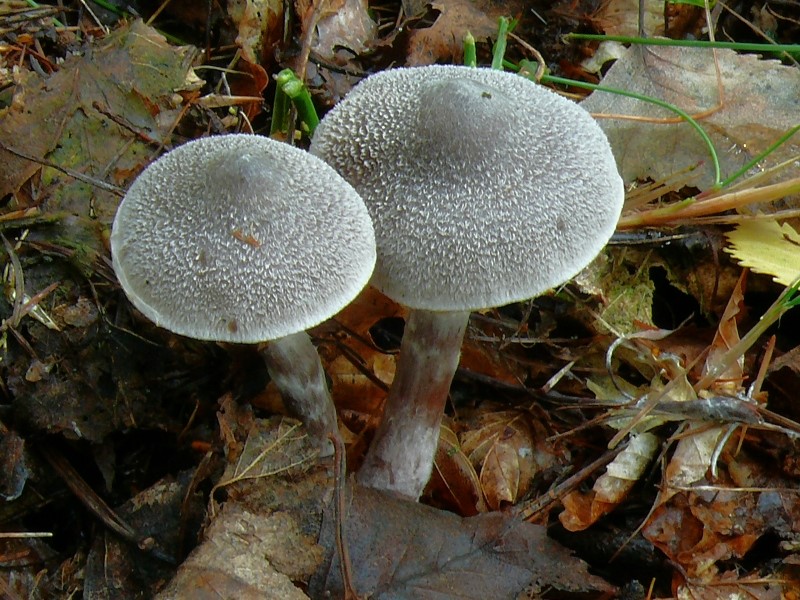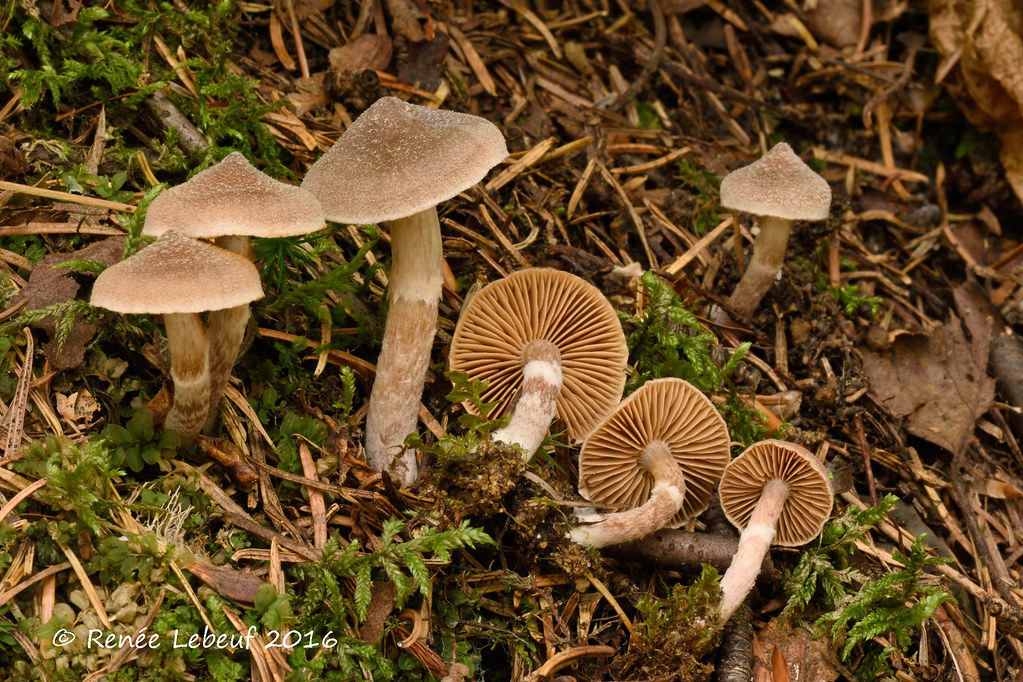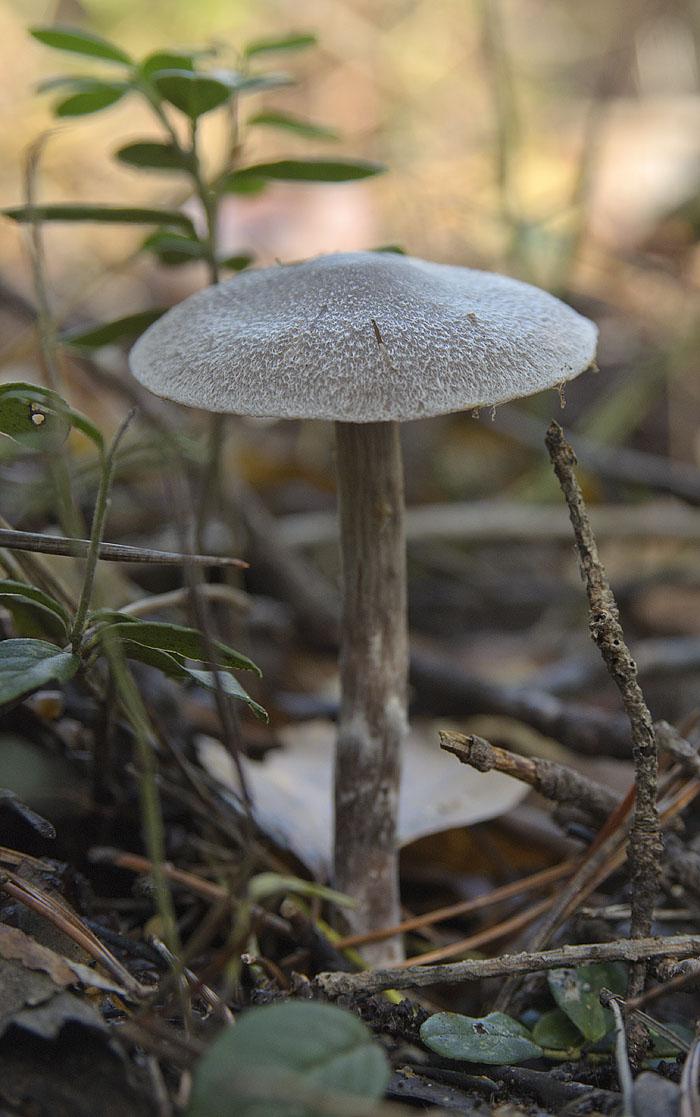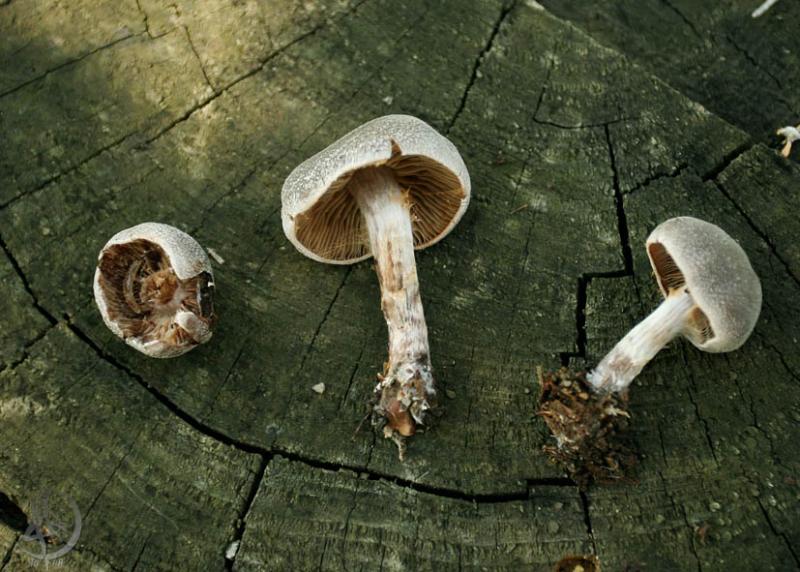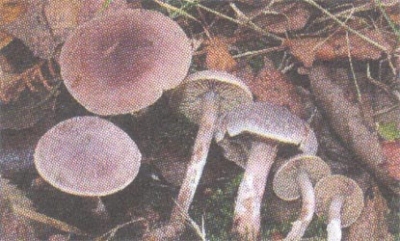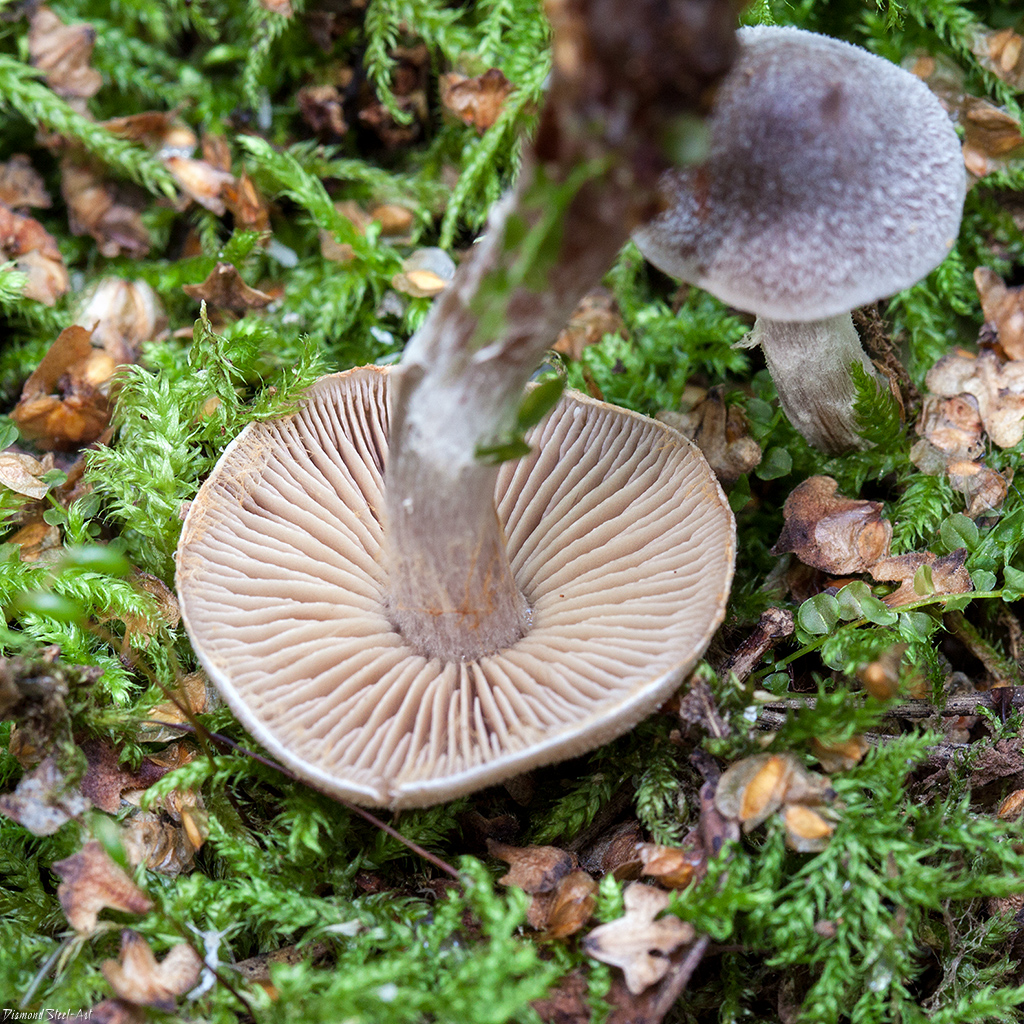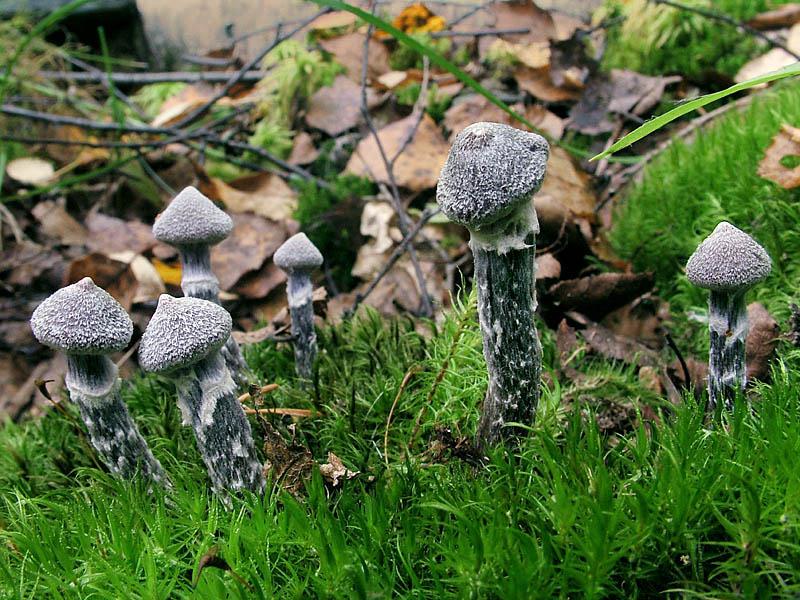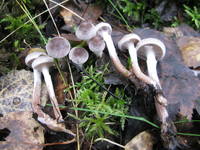Description of the semi-hairy webcap
His cap is first conical, usually with a sharp top, then becomes prostrate with the edges tucked down, while the sharp tubercle is often preserved. Its diameter is 3-4 centimeters.

The surface of the cap is whitish with hairy scales. The general background of the cap is brownish-brown or dark brown, and the villi are gray-fawn or whitish, which makes the mushroom look bluish-white. The edges are wavy and lighter. In rainy weather, the cap is almost smooth, bluish-brown or brown-brown, and when it dries, it becomes whitish again.
The blades are wide, sparse, and notched in shape. Plates grow with teeth. The color of the plates is gray-brown at first, but later becomes brown-brown. Rusty brown spore powder. Cobweb bedspread of white color. The pulp is thin, odorless, brown in color.
The leg is straight, cylindrical. Its structure is silky fibrous. Its length is 2-6 centimeters, and its thickness is 0.5 centimeters. The leg is hollow inside. The color of the leg is first white, then it turns brown or brown. On the stem, brown fibers and whitish remains of the bedspread stand out.

Places of growth of semi-hairy cobwebs
Semi-hairy cobwebs bear fruit from August to September. They grow in forests mixed with birch and spruce. These mushrooms settle on leaf litter, in the soil. They choose humid places. Semi-hairy cobwebs are found in small groups. You can rarely see these mushrooms in the forest.
Classification and representatives
Main article: Taxa of the genus Spiderweb
On the basis of macroscopic, microscopic and chemical characters, the genus is divided into 4-7 taxa, which were previously considered as subgenera or sections; in new systems, subgenera are divided into a large number of sections.
In 1821 E. Fries divided the genus into 6 subgenera: Myxacium, Phlegmacium, Inoloma (= Cortinarius sensu stricto), Dermocybe, Telamonia and Hydrocybe... Moser in 1955, taking the Fries system as a basis, identified 5 independent genera, but he (together with Singer) in 1962 again lowered their rank to subgenera, with changes in their composition.This classification is also adopted in new systems, but the assignment of species to subgenera can vary considerably among different authors.
Cortinarius - one of the largest genera of the Agarikov order. Different authors indicate a different number of species in the genus, usually up to 700, but according to the most complete edition - "Dictionary of mushrooms", the number of species exceeds 2000.
Subgenera (according to Nezdoyminy (1996), corresponds to the Moser - Singer system (1962)):
- Phlegmacium (Fr.) Fr.
- Sericeocybe P.D. Orton
- Myxacium (Fr.) Loud.
- Telamonia (Fr.) Loud.
- Leprocybe Mos.
- Cortinarius
- Dermocybe (Fr.) Sacc.
Some species:
| Cat. * | Latin name | Russian name | ||||||||||
|---|---|---|---|---|---|---|---|---|---|---|---|---|
| Cortinarius alboviolaceus | Webcap white-purple | |||||||||||
| Cortinarius balteatocumatilis | Webcap bluish belted | |||||||||||
| Cortinarius anomalus | The webcap is abnormal | |||||||||||
| Cortinarius anserinus | Goose webcap | |||||||||||
| Cortinarius armillatus | Bracelet webcap | |||||||||||
| Cortinarius auroturbinatus | Beautiful clubfoot webcap | |||||||||||
| Cortinarius bolaris | Lazy webcap, or red-scaly, or hulk webcap | |||||||||||
| Cortinarius camphoratus | Webcap camphor | |||||||||||
| Cortinarius cinnamomeus | Cinnamon webcap | |||||||||||
| Cortinarius collinitus | Blue-bore webcap | |||||||||||
| Cortinarius cotoneus | Wadded webcap | |||||||||||
| Cortinarius crassus | Thick-fleshy webcap | |||||||||||
| Cortinarius cumatilis | Spider web is watery blue, or gray-blue | |||||||||||
| Cortinarius elegantior | The webcap is elegant | |||||||||||
| Cortinarius elegantissimus | The most elegant webcap | |||||||||||
| Cortinarius evernius | The webcap is brilliant | |||||||||||
| Cortinarius herculeus | Webcap of Hercules | |||||||||||
| Cortinarius largus | The webcap is large, or abundant | |||||||||||
| Cortinarius limonius | Cobweb lion-yellow | |||||||||||
| Cortinarius mucosus | Slimy webcap | |||||||||||
| Cortinarius multiformis | Diverse webcap | |||||||||||
| Cortinarius odorifer | Anise webcap | |||||||||||
| Cortinarius orellanus | Mountain webcap, or plush, or orange-red, or poisonous | |||||||||||
| Cortinarius paleaceus | Filmy webcap | |||||||||||
| Cortinarius phoeniceus | Cobweb purple | |||||||||||
| Cortinarius pholideus | Scaly webcap | |||||||||||
| Cortinarius praestans | The webcap is excellent | |||||||||||
| Cortinarius purpurascens | The webcap is crimson, or reddish | |||||||||||
| Cortinarius rubellus | Reddish cobweb | |||||||||||
| Cortinarius rufoolivaceus | Red & olive spiderweb | |||||||||||
| Cortinarius sanguineis | Webcap blood red | |||||||||||
| Cortinarius semisanguineus | Webcap half-blood red | |||||||||||
| Cortinarius sodagnitis | The cobweb is recognizable | |||||||||||
| Cortinarius speciosissimus | The webcap is beautiful | |||||||||||
| Cortinarius splendens | The webcap is shiny | |||||||||||
| Cortinarius terpsichores | Webcap of Terpsichore | |||||||||||
| Cortinarius torvus | Gloomy webcap | |||||||||||
| Cortinarius traganus | Goat's webcap, or lilac thick-legged | |||||||||||
| Cortinarius triumphans | Triumphal webcap | |||||||||||
| Cortinarius trivialis | Common webcap | |||||||||||
| Cortinarius variecolor | Multi-colored webcap | |||||||||||
| Cortinarius varius | Changeable webcap, or brick-yellow | |||||||||||
| Cortinarius violaceus | Webcap purple | |||||||||||
|
Cinnamon webcap
The webcap is dark brown;
Cinnamon spiderweb (Cortinarius cinnamomeus) is a type of mushroom belonging to the Spiderweb family, the Spiderweb genus. This mushroom is also called brown spider web, or dark brown spider web.
The brown webcap is also called the species Cortinarius brunneus (dark brown webcap), which is not related to this.
External description
The cinnamon webcap has a cap with a diameter of 2-4 cm, characterized by a hemispherical convex shape. Over time, the cap becomes open. In its central part there is a noticeable obtuse tubercle. The surface of the cap is dry to the touch, fibrous in structure, yellowish brownish brown or yellowish olive brown in color.
The mushroom stem is characterized by a cylindrical shape, initially well filled on the inside, but gradually becomes hollow. In girth, it is 0.3-0.6 cm, and in length it can vary from 2 to 8 cm. The color of the leg is yellowish-brown, lightening towards the base. The pulp of the mushroom has a yellow tint, sometimes turning into olive, it does not have a strong smell and taste.
The fungal hymenophore is represented by the lamellar type, consists of adherent yellow plates, gradually becoming brownish-yellow. In color, the plates are similar to a mushroom cap. They are thin in structure, often located.
Season and habitat
The cinnamon spider web begins to bear fruit in late summer and continues to harvest throughout September. Grows in deciduous and coniferous forests, widespread in the boreal zones of North America and Eurasia. Occurs in groups and singly.
Edibility
The nutritional properties of this type of mushroom are not fully understood. The unpleasant taste of the cinnamon spiderweb pulp makes it unfit for human consumption. This mushroom has several related species, which differ in their poisonousness. However, no poisonous substances were found in the cinnamon spider web; it is absolutely safe for human health.
Similar types and differences from them
One of the types of mushrooms similar to the cinnamon spider web is the saffron spider web. Their main difference from each other is the color of the hymenophore plates in young fruit chalk. In cinnamon cobweb, the plates have rich orange hues, and in saffron, the color of the plates tends to be more yellow. Sometimes there is confusion with the name of the cinnamon spider web. This term is often called a dark-brown spider web (Cortinarius brunneus), which is not even one of the species related to the described spider web.
An interesting fact is that the cinnamon spider web has the properties of dyeing materials. For example, with the help of its juice, you can easily dye wool in a rich burgundy red.
Definitioner
- rare (rare smell)
-
In mycology, a rare smell, English. "Raphanoid", is interpreted very loosely and often denotes any smell of raw root vegetables, including potato, ie. not necessarily as sharp, sharp, and crisp as black or white radish.
- Basidia (Basidia)
-
Lat. Basidia. A specialized structure of sexual reproduction in fungi, inherent only in Basidiomycetes. Basidia are terminal (end) elements of hyphae of various shapes and sizes, on which spores develop exogenously (outside).
Basidia are diverse in structure and method of attachment to hyphae.
According to the position relative to the axis of the hypha, to which they are attached, three types of basidia are distinguished:
Apical basidia are formed from the terminal cell of the hypha and are located parallel to its axis.
Pleurobasidia are formed from lateral processes and are located perpendicular to the axis of the hypha, which continues to grow and can form new processes with basidia.
Subasidia are formed from a lateral process, turned perpendicular to the axis of the hypha, which, after the formation of one basidium, stops its growth.
Based on morphology:
Holobasidia - unicellular basidia, not divided by septa (see Fig. A, D.).
Phragmobasidia are divided by transverse or vertical septa, usually into four cells (see Fig. B, C).
By type of development:
Heterobasidia consists of two parts - hypobasidia and epibasidia developing from it, with or without partitions (see Fig. C, B) (see Fig. D).
Homobasidia is not divided into hypo- and epibasidia and in all cases is considered holobasidia (Fig. A).
Basidia is the place of karyogamy, meiosis and the formation of basidiospores. Homobasidia, as a rule, is not functionally divided, and meiosis follows karyogamy in it. However, basidia can be divided into probasidia - the site of karyogamy and metabasidia - the site of meiosis. Probasidium is often a dormant spore, for example in rust fungi. In such cases, probazidia grows with metabasidia, in which meiosis occurs and on which basidiospores are formed (see Fig. E).
See Karyogamy, Meiosis, Gifa.
- Pileipellis
-
Lat. Pileipellis, skin - differentiated surface layer of the cap of agaricoid basidiomycetes. The structure of the skin in most cases differs from the inner flesh of the cap and may have a different structure. The structural features of pileipellis are often used as diagnostic features in descriptions of fungi species.
According to their structure, they are divided into four main types: cutis, trichoderma, hymeniderma and epithelium.
See Agaricoid fungi, Basidiomycete, Cutis, Trichoderma, Gimeniderm, Epithelium.
Evaluation of the edibility of the semi-hairy cobweb
This mushroom belongs to the inedible species.
Other cobwebs
The scarlet webcap is similar in appearance to the semi-hairy cobweb, but its leg is less thick and shorter. The places of growth of these mushrooms also differ. The scarlet webcap is also inedible. Its cap does not exceed 3 centimeters in diameter, it is bell-shaped in shape, dark brown in color with whitish scales.

The leg of the scarious webcap is long - up to 15 centimeters, curved, tough, thin. The color of the leg is brownish-brown, and the surface is covered with whitish scales. The pulp is fragile and thin.
Fruiting of scarious cobwebs occurs from July to September. They settle in forests mixed with birch. You can find them in mosses, around swamps. These mushrooms are rare, but sometimes they can be quite abundant.
Silver webcap is an inedible mushroom. Its cap is very convex at first, and then becomes flat. Its diameter is approximately 7 centimeters. The color of the cap is silver. The surface of the cap is folded, wrinkled, silky. The leg expands noticeably downward, its height reaches 10 centimeters. The color of the leg is gray or brown. The pulp is very fleshy.

Silver cobwebs grow everywhere, but mostly come across in conifers. Fruiting in August-September, less common in October. Fruiting is stable every year.
Semi-hairy webcap: photo and description
| Name: | Semi-hairy webcap |
| Latin name: | Cortinarius hemitrichus |
| Type of: | Inedible |
| Specifications: |
|
| Systematics: |
|
The semi-hairy webcap belongs to the Cobweb family, genus Cortinarius. His the Latin name is Cortinarius hemitrichus.
Description of the semi-hairy webcap
The study of the characteristic features of the semi-hairy spider web allows us to distinguish it from other fungi. This representative of the forest kingdom is poisonous, so it should not be collected.
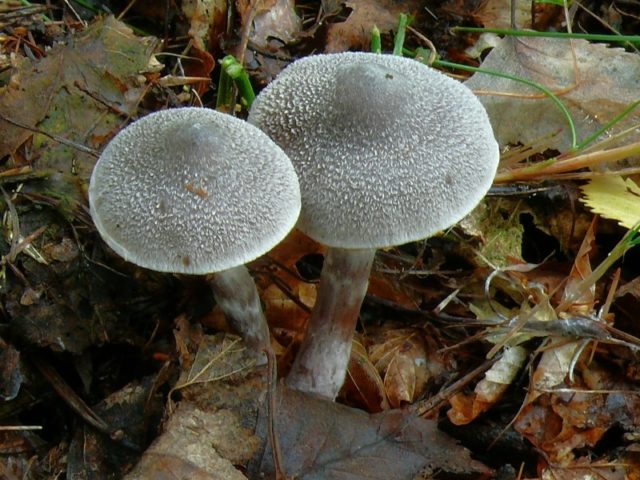
Description of the hat
The diameter of the cap is 3-4 cm. At first, it has a conical shape, whitish in color. On its surface there are hairy scales and a whitish veil.
As the fruiting body grows, it becomes more convex, then extended, the edges are lowered.
The color scheme differs depending on the maturity of the specimen: thanks to the villi, it is at first glaucous-whitish, gradually changing color to brown or gray-brown if it gets under rain. In dry weather, the cap becomes whitish again.
The plates are wide, but rather rare, have adherent teeth, which are at first a grayish-brown hue, but later the color becomes more saturated: brownish-brown. Cobweb bedspread of white shade.

Spore powder in rusty-brown fruit bodies
Leg description
The length of the lower part is from 4 to 8 cm, the diameter is up to 1 cm. The shape is cylindrical, even, but there are specimens with an expanded base. Silky fibrous to the touch. The leg is hollow inside. Its color is at first whitish, but gradually it turns brown and turns brown.

Brown fibers and remains of the bedspread remain on the leg
Where and how it grows
The fruiting period of the mushroom lasts from mid-August to September. Fruit bodies grow in mixed plantings, giving preference to leaf litter under birches and spruces. Small groups of specimens are found in humid areas.
Is the mushroom edible or not
The hairy webcap is absolutely not edible and poisonous, therefore it is prohibited to eat it. Its pulp is thin, without a special aroma, brown tint.
Doubles and their differences
The look is similar to the filmy cobweb, the flesh of which is thin, firm in the leg, with a slight aroma of geranium. The cap of the twin is in the form of a dark brown bell with villi, has a sharp mastoid tubercle.
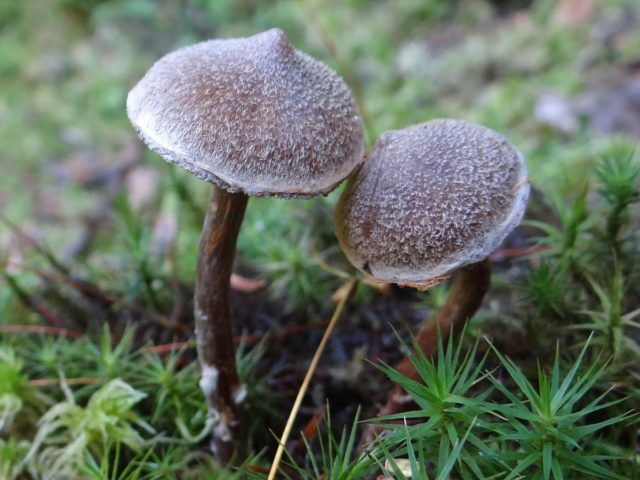
Unlike the semi-hairy cobweb, the twin is smaller in size, but with distinct scales, grows on moss, giving preference to swampy areas.
Conclusion
The semi-hairy webcap belongs to the category of inedible fruit chalk. Grows in mixed plantings. It occurs from August to September.

